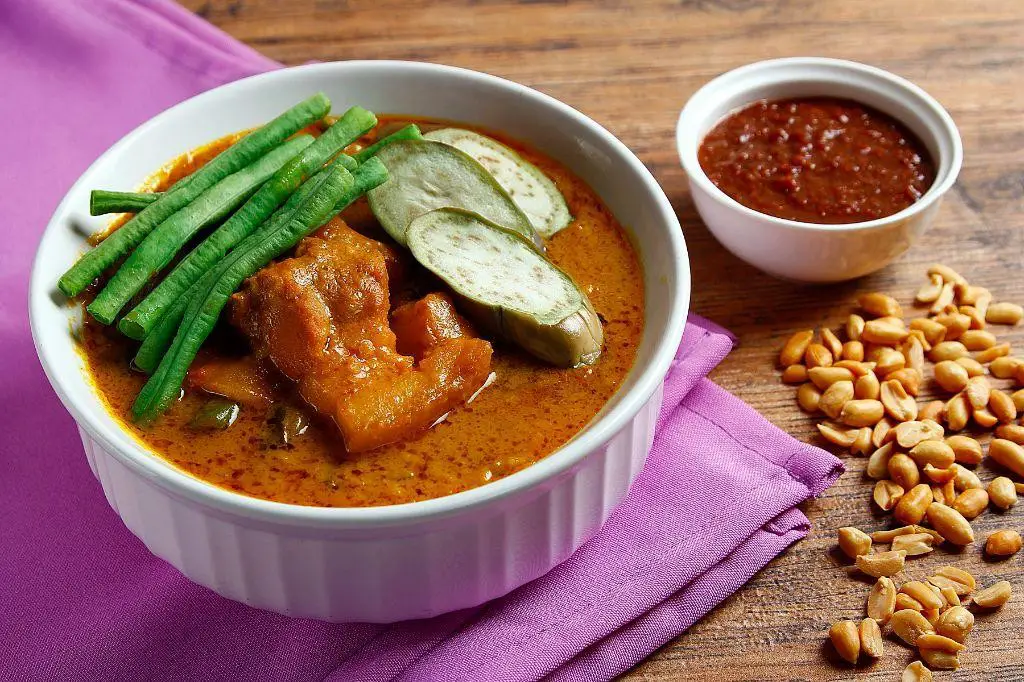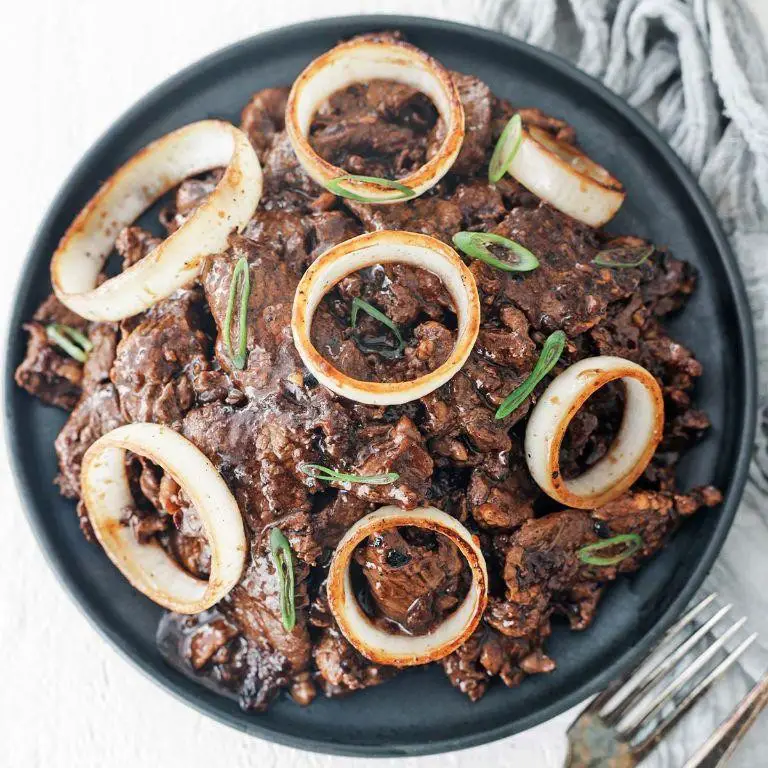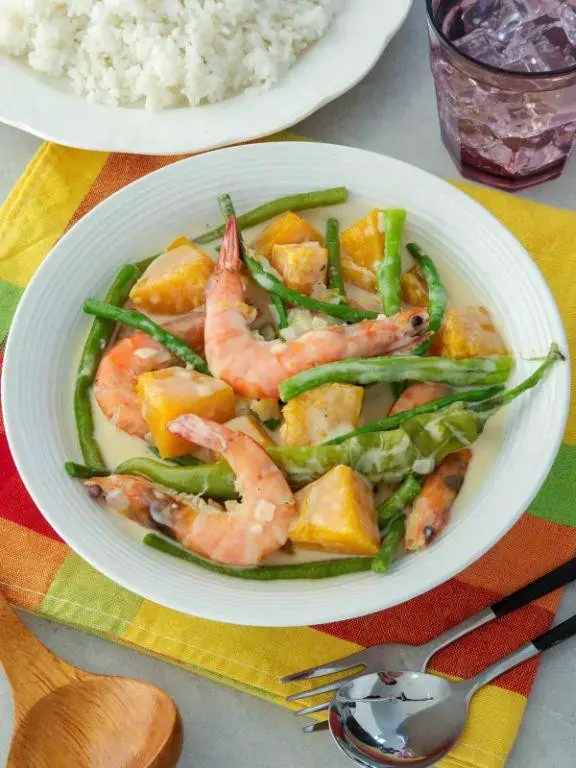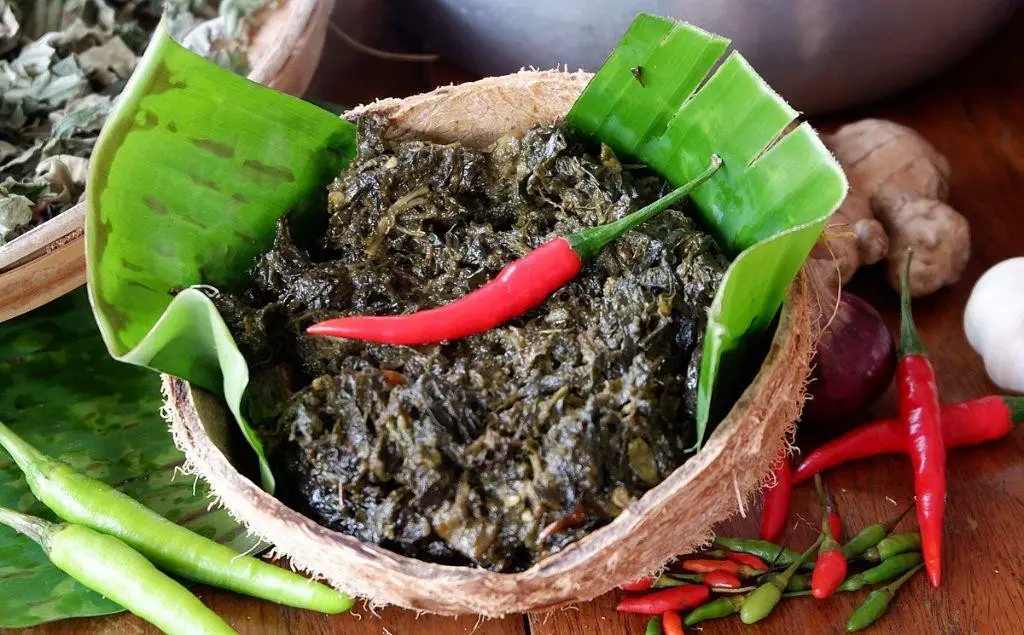Kickstart your culinary adventure with the vibrant flavors of the Philippines! Perfect for beginners, these 18 easy-to-follow recipes bring the warmth and richness of Filipino cuisine right to your North American kitchen. From hearty comfort foods to quick, flavorful dinners, there’s something for every taste. Dive in and discover how simple it can be to create delicious Filipino dishes at home. Let’s get cooking!
Chicken Adobo

You’ve probably heard of Chicken Adobo, but have you ever tried making it at home? It’s easier than you think and packs a punch of flavor that’ll have you coming back for seconds.
Ingredients
- A couple of pounds of chicken thighs
- A splash of soy sauce
- A splash of vinegar
- A few cloves of garlic, smashed
- A couple of bay leaves
- A sprinkle of black pepper
- A cup of water
- A tablespoon of oil
Instructions
- Heat the oil in a large pan over medium heat. Tip: Make sure the pan is hot enough so the chicken sizzles when it hits the pan.
- Add the chicken thighs, skin side down, and cook until golden brown, about 5 minutes per side. Tip: Don’t overcrowd the pan; cook in batches if necessary.
- Remove the chicken and set aside. In the same pan, add the garlic and cook until fragrant, about 30 seconds.
- Pour in the soy sauce, vinegar, water, add the bay leaves, and sprinkle with black pepper. Tip: The vinegar will mellow as it cooks, so don’t worry if it smells strong at first.
- Bring the mixture to a boil, then return the chicken to the pan. Reduce heat to low, cover, and simmer for 30 minutes.
- Uncover and simmer for another 10 minutes to reduce the sauce slightly.
- Remove the bay leaves before serving.
Perfectly tender chicken with a tangy, savory sauce that’s just begging to be poured over a heap of steamed rice. Try serving it with a side of pickled vegetables for an extra crunch.
Pork Sinigang

Bold flavors and comforting warmth are what you’ll get with this Pork Sinigang recipe. It’s a tangy, savory soup that’s perfect for those days when you need something to warm you up from the inside out.
Ingredients
- 1.5 lbs of pork shoulder, cut into chunks
- 8 cups of water
- 1 large onion, quartered
- 2 tomatoes, quartered
- 1 bunch of spinach
- 1 eggplant, sliced
- 2 green chilies
- 1 packet of sinigang mix (tamarind soup base)
- A splash of fish sauce
- A couple of cups of cooked rice, to serve
Instructions
- In a large pot, bring the water to a boil over high heat.
- Add the pork chunks and let it boil for about 10 minutes, skimming off any scum that rises to the top.
- Toss in the onion and tomatoes, then lower the heat to a simmer. Let it cook for another 20 minutes until the pork is tender.
- Stir in the sinigang mix and fish sauce, adjusting the amount to your liking for that perfect tangy flavor.
- Add the eggplant and green chilies, simmering for about 5 minutes until the vegetables are just tender.
- Throw in the spinach last, letting it wilt for about a minute before turning off the heat.
- Serve hot with a side of cooked rice for a complete meal.
Just imagine the tender pork, the slight crunch of the vegetables, and that tangy broth that ties it all together. Try serving it with a side of patis (fish sauce) with calamansi for an extra kick!
Beef Kaldereta

You’ve probably had your fair share of stews, but Beef Kaldereta is a game-changer with its rich, tomato-based sauce and tender chunks of beef. It’s a Filipino classic that’s hearty, flavorful, and just the thing to spice up your dinner routine.
Ingredients
- 2 lbs beef chuck, cut into 1-inch cubes
- a couple of tablespoons of olive oil
- 1 large onion, chopped
- 4 cloves garlic, minced
- a splash of soy sauce
- 1 cup tomato sauce
- 1 cup beef broth
- 1 red bell pepper, sliced
- 1 green bell pepper, sliced
- 2 potatoes, cubed
- 1 carrot, sliced
- a handful of green olives
- a sprinkle of salt and pepper
- a dash of liver spread (optional for authenticity)
Instructions
- Heat the olive oil in a large pot over medium heat. Tip: Make sure the pot is big enough to hold all the ingredients comfortably.
- Add the beef cubes and brown them on all sides, about 5 minutes. Tip: Don’t overcrowd the pot to ensure each piece gets a nice sear.
- Toss in the onion and garlic, sautéing until they’re soft and fragrant, about 3 minutes.
- Pour in the soy sauce, tomato sauce, and beef broth, stirring to combine. Bring to a simmer.
- Lower the heat, cover, and let it cook for about 1.5 hours, or until the beef is tender. Tip: Check occasionally to make sure there’s enough liquid; add a bit more broth if needed.
- Add the bell peppers, potatoes, carrot, and olives. Cook for another 20 minutes, or until the vegetables are tender.
- Stir in the liver spread if using, and season with salt and pepper to taste. Let it simmer for another 5 minutes.
Finished with a silky sauce and melt-in-your-mouth beef, this Kaldereta is a comforting bowl of goodness. Serve it over steamed rice or with a side of crusty bread to soak up all that delicious sauce.
Pancit Canton

Bust out your wok because we’re diving into Pancit Canton, a Filipino noodle dish that’s as fun to make as it is to eat. Perfect for when you’re craving something savory, a bit tangy, and totally satisfying.
Ingredients
- 8 oz Pancit Canton noodles
- 2 cups of chicken broth
- 2 tbsp soy sauce
- 1 tbsp oyster sauce
- a splash of vegetable oil
- a couple of garlic cloves, minced
- 1 small onion, sliced
- 1 cup of sliced carrots
- 1 cup of sliced cabbage
- a handful of green beans, cut into pieces
- 1 cup of sliced chicken breast
- a sprinkle of ground black pepper
Instructions
- Soak the Pancit Canton noodles in warm water for about 5 minutes, then drain. Tip: Don’t over-soak to keep them chewy.
- Heat a splash of vegetable oil in your wok over medium-high heat. Add the minced garlic and sliced onion, sauté until they’re golden and fragrant.
- Toss in the chicken breast slices, cooking until they’re no longer pink. Tip: Keep the pieces moving for even cooking.
- Add the carrots, cabbage, and green beans, stirring for about 3 minutes until they’re slightly tender but still crisp.
- Pour in the chicken broth, soy sauce, and oyster sauce, bringing the mix to a gentle boil. Tip: This is your sauce base, so let it simmer to blend the flavors.
- Add the drained noodles to the wok, tossing everything together until the noodles are well-coated and have absorbed most of the liquid, about 5 minutes.
- Finish with a sprinkle of ground black pepper, give it one final toss, and you’re ready to serve.
Kick back and enjoy your Pancit Canton, where every forkful is a mix of tender noodles, crisp veggies, and savory chicken. Serve it up with a wedge of lemon on the side for an extra zing, or top with a fried egg for a hearty twist.
Lumpiang Shanghai

Now, let’s dive into making Lumpiang Shanghai, a crispy, flavorful Filipino spring roll that’s perfect for any gathering or a cozy night in. You’ll love how these little rolls pack a punch with every bite.
Ingredients
- 1 pound ground pork
- 1 cup finely chopped carrots
- 1 cup finely chopped onions
- 2 cloves garlic, minced
- 1 egg
- 1 tablespoon soy sauce
- a splash of sesame oil
- a couple of dashes of salt and pepper
- 1 package spring roll wrappers
- 2 cups vegetable oil for frying
Instructions
- In a large bowl, mix together the ground pork, carrots, onions, garlic, egg, soy sauce, sesame oil, salt, and pepper until well combined. Tip: For extra flavor, let the mixture sit in the fridge for an hour.
- Lay out a spring roll wrapper on a clean surface. Place about a tablespoon of the pork mixture near one corner of the wrapper.
- Fold the corner over the filling, then fold in the sides, and roll tightly to seal. Tip: Use a bit of water on the edges to help seal the roll if needed.
- Heat the vegetable oil in a deep pan over medium heat until it reaches 350°F. Tip: To test if the oil is ready, drop a small piece of wrapper in; if it sizzles immediately, you’re good to go.
- Fry the rolls in batches, turning occasionally, until golden brown and crispy, about 3-4 minutes per batch. Drain on paper towels.
These Lumpiang Shanghai rolls come out incredibly crispy on the outside with a juicy, savory filling inside. Serve them with a sweet chili sauce for dipping, or get creative by wrapping them in lettuce leaves for a fresh crunch.
Tinolang Manok

Craving something comforting yet light? Tinolang Manok is your go-to Filipino chicken soup, simmered with ginger, green papaya, and leafy greens—perfect for any day.
Ingredients
- 1 whole chicken, cut into serving pieces
- a thumb-sized piece of ginger, sliced
- 4 cloves of garlic, minced
- 1 medium onion, chopped
- 2 tablespoons of fish sauce
- 6 cups of water
- 1 small green papaya, peeled and cubed
- a couple of handfuls of spinach or chili leaves
- a splash of cooking oil
- salt and pepper, just enough to season
Instructions
- Heat a splash of cooking oil in a large pot over medium heat.
- Sauté the ginger, garlic, and onion until fragrant, about 2 minutes. Tip: Don’t rush this step—the aroma is key to the soup’s flavor.
- Add the chicken pieces and cook until they’re no longer pink, around 5 minutes.
- Pour in the water and bring to a boil. Skim off any foam that rises to the top for a clearer broth.
- Lower the heat, add the fish sauce, and simmer for 20 minutes. Tip: This slow cooking makes the chicken tender and infuses the broth with flavor.
- Add the green papaya and cook until it’s tender but still firm, about 5 minutes. Tip: Test the papaya with a fork—it should pierce easily but not be mushy.
- Throw in the spinach or chili leaves and cook for another minute.
- Season with salt and pepper, then turn off the heat.
Out of the pot, this Tinolang Manok is a harmony of tender chicken, slightly sweet papaya, and a ginger-kissed broth. Serve it steaming hot with a side of rice for the ultimate comfort meal.
Kare-Kare

Feeling adventurous in the kitchen? Let’s dive into making Kare-Kare, a rich and savory Filipino stew that’s all about comfort and flavor. It’s a dish that brings together tender oxtail, a creamy peanut sauce, and a mix of veggies for something truly special.
Ingredients
- 2 lbs oxtail, cut into chunks
- a couple of cups of water
- a splash of oil
- 3 cloves garlic, minced
- 1 onion, chopped
- 2 tbsp annatto seeds (soaked in 1/4 cup warm water)
- 1/2 cup smooth peanut butter
- 1 tbsp fish sauce
- 1 eggplant, sliced
- 1 bundle of string beans, cut into 2-inch pieces
- 1 banana heart, sliced (optional)
- a handful of bok choy
Instructions
- In a large pot, boil the oxtail in water until tender, about 2-3 hours. Skim off any foam that rises to the top.
- Heat oil in a pan over medium heat. Sauté garlic and onion until soft.
- Add the annatto seed water to the pan for color, then stir in the peanut butter and fish sauce. Tip: Keep the heat low to prevent the peanut butter from burning.
- Transfer the peanut mixture to the pot with the oxtail. Simmer for 10 minutes to blend the flavors.
- Add the eggplant, string beans, and banana heart. Cook for another 5-7 minutes until the veggies are tender. Tip: Add the bok choy last to keep it crisp.
- Serve hot with a side of bagoong (shrimp paste) for an authentic touch. Tip: If you’re not a fan of shrimp paste, a little soy sauce works too.
Unbelievably creamy and packed with umami, this Kare-Kare is a bowl of comfort. The oxtail melts in your mouth, and the peanut sauce? Absolutely addictive. Try serving it over steamed rice for the ultimate meal.
Lechon Kawali

Very few dishes can compete with the crispy, golden perfection of Lechon Kawali. It’s that Filipino favorite you’ve probably seen all over social media, and trust me, it’s as delicious as it looks.
Ingredients
- 2 lbs pork belly, cut into chunks
- 4 cups water
- a couple of bay leaves
- a splash of soy sauce
- a tablespoon of salt
- enough oil for deep frying
Instructions
- In a large pot, combine the pork belly, water, bay leaves, soy sauce, and salt. Bring to a boil over high heat.
- Once boiling, lower the heat to medium and let it simmer for about 45 minutes, or until the pork is tender but not falling apart. Tip: Skim off any scum that rises to the top for a clearer broth.
- Remove the pork from the pot and let it dry on a rack for at least 30 minutes. This step is crucial for that crispy skin later on.
- Heat oil in a deep fryer or large pot to 375°F. Carefully add the pork pieces and fry until golden brown and crispy, about 5-7 minutes. Tip: Do this in batches to avoid overcrowding and ensure even cooking.
- Transfer the fried pork to a paper towel-lined plate to drain excess oil. Tip: Let it rest for a few minutes before slicing to keep the juices in.
Zesty and bursting with flavor, Lechon Kawali is best served with a side of steamed rice and a dipping sauce made from vinegar, soy sauce, and a bit of chili. The contrast between the crispy exterior and the tender, juicy meat inside is simply irresistible.
Sinigang na Baboy

Perfect for those days when you’re craving something tangy and comforting, Sinigang na Baboy is a Filipino sour soup that’s both hearty and refreshing. You’ll love how the tamarind gives it a unique kick, making it a standout dish.
Ingredients
- 2 lbs pork ribs, cut into chunks
- 8 cups water
- 1 large onion, quartered
- 2 tomatoes, quartered
- 1 bunch of spinach, roughly chopped
- 2 eggplants, sliced
- 1 daikon radish, sliced
- 2 green chilies
- 1 packet of tamarind soup base (about 1.4 oz)
- A splash of fish sauce
- A couple of okra, trimmed
Instructions
- In a large pot, bring the water to a boil over high heat.
- Add the pork ribs and let them boil for about 5 minutes, then skim off any scum that rises to the top. Tip: This keeps your broth clear and clean-tasting.
- Toss in the onion and tomatoes, then lower the heat to medium and simmer for about 40 minutes until the pork is tender.
- Stir in the tamarind soup base until it’s fully dissolved, then add the daikon radish and okra. Simmer for another 10 minutes. Tip: The radish should be tender but still hold its shape.
- Add the eggplants and green chilies, cooking for about 5 minutes until the eggplants are soft.
- Finally, throw in the spinach and a splash of fish sauce, then turn off the heat after a minute. Tip: The spinach wilts quickly, so add it last to keep its vibrant color.
Rich in flavors and textures, this Sinigang na Baboy is best enjoyed hot, with the sourness perfectly balanced by the savory pork. Try serving it with a side of steamed rice to soak up all that delicious broth.
Pinakbet

You’ve probably heard of Pinakbet, but have you ever tried making it at home? It’s a vibrant Filipino veggie stew that’s as fun to say as it is to eat, packed with flavors that’ll make your taste buds dance.
Ingredients
- 2 cups of squash, cubed
- 1 cup of okra, ends trimmed
- 1 cup of eggplant, sliced
- 1 cup of string beans, cut into 2-inch pieces
- 1 cup of bitter melon, sliced (optional for the brave)
- 1/2 cup of pork belly, sliced into small pieces
- 3 cloves of garlic, minced
- 1 small onion, diced
- 1 tomato, chopped
- 2 tbsp of shrimp paste
- A splash of water
- A drizzle of oil
Instructions
- Heat a drizzle of oil in a large pan over medium heat. Tip: Make sure the pan is hot enough to sizzle the pork but not burn it.
- Add the pork belly slices and cook until they’re golden and crispy, about 5 minutes. Tip: Render the fat well for extra flavor.
- Toss in the garlic, onion, and tomato. Sauté until the onion is translucent, about 3 minutes.
- Stir in the shrimp paste and cook for another minute to blend the flavors.
- Add a splash of water, then layer in the squash. Cover and simmer for 5 minutes. Tip: Squash takes the longest to cook, so it goes in first.
- Add the okra, eggplant, string beans, and bitter melon if using. Cover and simmer for another 7 minutes, or until all veggies are tender but not mushy.
- Give everything a gentle stir to mix the flavors without breaking the veggies.
Zesty and hearty, this Pinakbet is a colorful mix of textures, from the creamy squash to the crisp okra. Serve it over steamed rice with an extra dab of shrimp paste on the side for those who love a punch of umami.
Bistek Tagalog

Wondering what to cook for dinner that’s both hearty and bursting with flavor? Let me introduce you to Bistek Tagalog, a Filipino classic that’s all about tender beef slices swimming in a savory, citrusy sauce. It’s the kind of dish that brings everyone to the table without fail.
Ingredients
- 1.5 lbs of beef sirloin, sliced thin
- a splash of soy sauce (about 1/2 cup)
- a couple of lemons, juiced (or about 1/4 cup of lemon juice)
- a handful of onions, sliced into rings
- a glug of cooking oil (about 2 tbsp)
- a pinch of ground black pepper
- a cup of water
Instructions
- Marinate the beef slices in soy sauce and lemon juice for at least 30 minutes. Tip: The longer it marinates, the more flavorful it gets.
- Heat the oil in a pan over medium-high heat. Add the marinated beef and cook until browned, about 3 minutes per side. Tip: Don’t overcrowd the pan to ensure each slice gets a nice sear.
- Remove the beef from the pan and set aside. In the same pan, sauté the onion rings until they’re soft and slightly caramelized, about 2 minutes.
- Return the beef to the pan. Pour in the marinade and a cup of water. Let it simmer for about 10 minutes, or until the sauce thickens slightly. Tip: Keep an eye on the sauce to prevent it from reducing too much.
- Season with a pinch of ground black pepper, give it a quick stir, and you’re done!
Bistek Tagalog is all about that perfect balance between savory and tangy, with the onions adding a sweet crunch. Serve it over a steaming pile of rice, or get creative by pairing it with a side of garlic fried rice for an extra kick.
Arroz Caldo

Kickstart your comfort food game with Arroz Caldo, a Filipino rice porridge that’s like a warm hug in a bowl. Perfect for those chilly evenings or when you’re feeling under the weather, it’s savory, slightly gingery, and totally customizable to your liking.
Ingredients
- 1 cup of jasmine rice
- 4 cups of chicken broth
- A couple of chicken thighs, bone-in
- A splash of fish sauce
- A thumb-sized piece of ginger, sliced
- 3 cloves of garlic, minced
- A small onion, diced
- A drizzle of cooking oil
- Hard-boiled eggs, for serving
- Green onions, chopped, for garnish
Instructions
- Heat a drizzle of cooking oil in a large pot over medium heat.
- Add the diced onion, minced garlic, and sliced ginger. Sauté until the onion is translucent, about 3 minutes.
- Add the chicken thighs to the pot. Brown them on both sides, about 5 minutes per side.
- Stir in the jasmine rice, making sure it’s well-coated with the oil and aromatics.
- Pour in the chicken broth and a splash of fish sauce. Bring to a boil, then lower the heat to a simmer.
- Cover the pot and let it cook for 30 minutes, stirring occasionally to prevent the rice from sticking to the bottom.
- After 30 minutes, remove the chicken thighs. Shred the meat off the bones and return it to the pot.
- Let the porridge simmer for another 10 minutes to thicken. If it’s too thick, add a bit more broth or water.
- Serve hot, garnished with chopped green onions and slices of hard-boiled eggs.
Delight in the creamy texture and rich flavors of Arroz Caldo, where the ginger adds a nice kick and the chicken makes it hearty. Try topping it with crispy garlic bits for an extra crunch, or a squeeze of calamansi for a tangy twist.
Ginataang Kalabasa at Sitaw

Unbelievably comforting and easy to whip up, Ginataang Kalabasa at Sitaw is a Filipino classic that’s all about creamy coconut milk, tender squash, and crisp string beans. You’ll love how these simple ingredients come together for a dish that’s both hearty and light.
Ingredients
- 1 tablespoon of vegetable oil
- 3 cloves of garlic, minced
- 1 small onion, chopped
- a couple of cups of kabocha squash, cut into chunks
- a handful of string beans, cut into 2-inch pieces
- a can (13.5 oz) of coconut milk
- a splash of fish sauce
- a pinch of salt and pepper
Instructions
- Heat the vegetable oil in a pan over medium heat. Tip: Make sure the pan is hot enough so the garlic doesn’t burn.
- Add the minced garlic and chopped onion. Sauté until the onion is translucent, about 2 minutes.
- Toss in the squash chunks. Stir them around to get a bit of color, about 3 minutes.
- Pour in the coconut milk and bring to a gentle simmer. Tip: Keep the heat medium-low to prevent the coconut milk from separating.
- Add the string beans and a splash of fish sauce. Let everything cook until the squash is tender but not mushy, about 10 minutes. Tip: The string beans should still have a bit of crunch for texture.
- Season with a pinch of salt and pepper. Give it a taste and adjust if needed.
So creamy and rich, this dish is perfect over steamed rice. The squash melts in your mouth, while the string beans add a nice contrast. Try topping it with some crispy fried garlic for an extra layer of flavor.
Laing

Ready to dive into a dish that’s a total game-changer for your taste buds? Laing is a Filipino favorite that’s all about taro leaves simmered in creamy coconut milk, with a kick of spice. It’s hearty, flavorful, and surprisingly easy to make at home.
Ingredients
- a couple of cups of dried taro leaves
- a can (13.5 oz) of coconut milk
- a splash of fish sauce
- a handful of shrimp paste
- a couple of cloves of garlic, minced
- a medium onion, sliced
- a thumb-sized piece of ginger, julienned
- a couple of red chilies, sliced (optional for heat)
- a tablespoon of cooking oil
Instructions
- Heat the oil in a large pot over medium heat. Toss in the garlic, onion, and ginger. Sauté until the onion turns translucent, about 3 minutes.
- Add the shrimp paste and chilies if using. Stir for a minute until everything’s nicely mixed and fragrant.
- Pour in the coconut milk and bring to a gentle simmer. Let it cook for about 5 minutes, stirring occasionally.
- Add the dried taro leaves, pushing them down into the liquid. Cover and simmer on low heat for 30 minutes. Stir every now and then to prevent sticking.
- After 30 minutes, check if the leaves are tender and the sauce has thickened. If not, give it another 10 minutes.
- Finish with a splash of fish sauce, stir well, and turn off the heat. Let it sit for 5 minutes before serving.
Here’s the deal: Laing is creamy with a slight chew from the taro leaves, and the coconut milk makes it rich without being heavy. Serve it over steamed rice or with a side of grilled fish for a meal that’s downright unforgettable.
Pork Menudo

This weekend, you’re in for a treat with Pork Menudo, a hearty Filipino stew that’s bursting with flavors. Think tender pork, savory liver, and a rich tomato sauce that’ll have you coming back for seconds.
Ingredients
- 2 lbs pork shoulder, cut into bite-sized pieces
- 1/2 lb pork liver, sliced thin
- 3 cloves garlic, minced
- 1 medium onion, diced
- 2 cups tomato sauce
- 1 cup water
- 2 potatoes, cubed
- 1 carrot, cubed
- 1 red bell pepper, sliced
- 1/2 cup green peas
- 2 tbsp soy sauce
- 1 tbsp fish sauce
- a splash of cooking oil
- a pinch of salt and pepper
Instructions
- Heat a splash of cooking oil in a large pot over medium heat. Tip: Make sure the oil is hot enough to sizzle a tiny piece of garlic.
- Add the minced garlic and diced onion. Sauté until the onion turns translucent, about 2 minutes.
- Toss in the pork shoulder pieces. Brown them on all sides, roughly 5 minutes. Tip: Don’t overcrowd the pot to ensure even browning.
- Stir in the tomato sauce, water, soy sauce, and fish sauce. Bring to a boil, then lower the heat to simmer for 30 minutes. Tip: Cover the pot to keep the moisture in.
- Add the pork liver, potatoes, and carrot. Simmer for another 15 minutes, or until the vegetables are tender.
- Throw in the red bell pepper and green peas. Cook for 5 more minutes.
- Season with a pinch of salt and pepper. Give it a good stir, then turn off the heat.
Velvety pork and liver pieces swim in a thick, savory sauce, with the potatoes and carrots adding a comforting bite. Serve it over steamed rice or with a side of crusty bread to soak up all that delicious sauce.
Chopsuey

Perfect for those nights when you want something quick, tasty, and packed with veggies, chopsuey is your go-to dish. It’s a colorful stir-fry that’s as fun to make as it is to eat, and guess what? You probably have most of the ingredients in your fridge right now.
Ingredients
- 2 cups of chopped mixed vegetables (think bell peppers, carrots, and snap peas)
- 1 cup of sliced mushrooms
- 1 cup of chopped chicken breast
- 2 cloves of garlic, minced
- A splash of soy sauce
- A couple of tablespoons of vegetable oil
- 1 cup of chicken broth
- A pinch of salt and pepper
Instructions
- Heat a large pan over medium-high heat and add the vegetable oil.
- Once the oil is hot, toss in the garlic and stir for about 30 seconds until it’s fragrant.
- Add the chicken to the pan and cook until it’s no longer pink, about 5 minutes. Tip: Cut the chicken into even pieces so they cook at the same rate.
- Throw in the mixed vegetables and mushrooms, stirring everything together.
- Pour in the soy sauce and chicken broth, then let it simmer for about 10 minutes until the vegetables are tender but still crisp. Tip: Don’t overcook the veggies to keep that nice crunch.
- Season with a pinch of salt and pepper, give it one final stir, and you’re done. Tip: Taste as you go and adjust the seasoning if needed.
Light and vibrant, this chopsuey is all about the crunch and the umami from the soy sauce. Serve it over a bed of steamed rice or noodles for a complete meal that’s sure to impress.
Bulalo

Ever heard of a soup that’s both hearty and refreshing? That’s Bulalo for you—a Filipino beef marrow stew that’s perfect for any day, whether you’re craving something comforting or just want to try something new.
Ingredients
- 2 lbs beef shanks, with marrow bones
- 1 large onion, quartered
- 4 cloves garlic, smashed
- 2 ears of corn, cut into thirds
- 2 medium potatoes, quartered
- 1 small cabbage, quartered
- a couple of peppercorns
- a splash of fish sauce
- 8 cups water
Instructions
- In a large pot, bring the water to a boil over high heat.
- Add the beef shanks and let it boil for about 5 minutes, then skim off the scum that rises to the top. Tip: This step ensures a clearer broth.
- Lower the heat to medium, then add the onion, garlic, and peppercorns. Let it simmer for 1.5 hours or until the beef is tender. Tip: Keep the lid slightly open to prevent the pot from boiling over.
- Add the corn and potatoes, then simmer for another 10 minutes.
- Toss in the cabbage and cook for 5 more minutes. Tip: Adding the cabbage last keeps it crisp and vibrant.
- Season with fish sauce to taste, then serve hot.
Ladle this rich, flavorful soup into bowls and enjoy the tender beef and the melt-in-your-mouth marrow. For an extra kick, serve it with a side of spicy fish sauce dip or steamed rice.
Pork BBQ Skewers

Hey, you know those days when you’re craving something smoky, sweet, and a little bit spicy? These pork BBQ skewers are your answer. Perfect for grilling season or whenever you need a quick, flavorful fix.
Ingredients
- 1.5 lbs of pork shoulder, cut into 1-inch cubes
- A couple of cloves of garlic, minced
- A splash of soy sauce
- 1/4 cup of brown sugar
- 2 tbsp of ketchup
- A dash of apple cider vinegar
- 1 tsp of smoked paprika
- 1/2 tsp of ground black pepper
- Wooden skewers, soaked in water for 30 minutes
Instructions
- In a bowl, mix the minced garlic, soy sauce, brown sugar, ketchup, apple cider vinegar, smoked paprika, and black pepper to make the marinade.
- Add the pork cubes to the marinade, ensuring each piece is well coated. Cover and refrigerate for at least 2 hours, or overnight for deeper flavor.
- Preheat your grill to medium-high heat, about 375°F, and lightly oil the grate to prevent sticking.
- Thread the marinated pork onto the soaked skewers, leaving a little space between each piece for even cooking.
- Grill the skewers for about 4-5 minutes on each side, or until the pork is nicely charred and reaches an internal temperature of 145°F.
- Let the skewers rest for a couple of minutes before serving to keep them juicy.
Look at those beauties! The pork is tender with a perfect caramelized crust, and the marinade gives it a sweet and tangy kick. Serve them over a bed of rice or with a side of grilled veggies for a complete meal.
Conclusion
Vibrant and varied, this collection of 18 Delicious Easy Filipino Recipes for Beginners is your gateway to exploring the rich flavors of the Philippines from your own kitchen. Whether you’re craving something sweet, savory, or in between, there’s a dish here to start your culinary adventure. Don’t forget to leave a comment with your favorite recipe and share the love by pinning this article on Pinterest. Happy cooking!

Michael Johnson is the founder of Pan Mastery, Inspired by his blacksmith grandfather’s legacy has a deep appreciation for hand-crafted pots and pans, he provides invaluable guides, reviews, and recipes to enhance your culinary journey.
